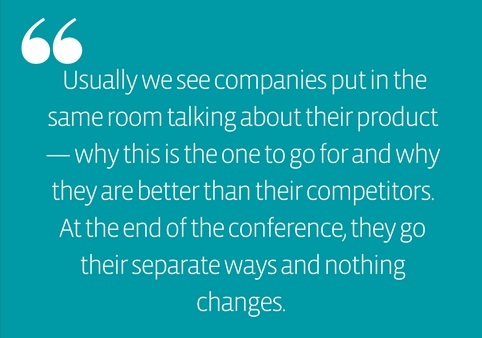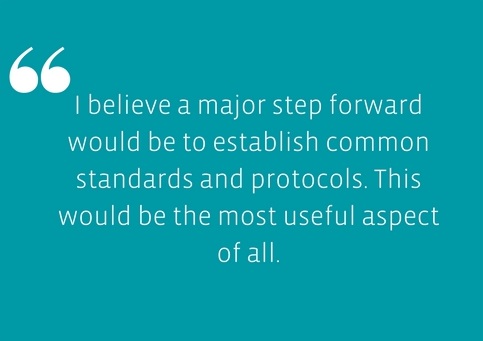Users — best ambassadors for innovative services
We’ve interviewed Daniel Seybold—Head of Operations at TeleOrbit GmbH—on why getting their clients to talk to their peers is more efficient than a business pitch, and on the main challenges companies face on the satellite applications market.
Eurisy (EY): Daniel you came to two of our events this year alone. You joined us earlier in May in Biarritz for our conference on Outdoor Sports: surfing avant-garde solutions and now TeleOrbit joined us for “Satellite Applications for the Alps” as one of our sponsors. What brought you to two of our events this year?
Daniel Seybold (DS): For the first event, we were invited to present one of our projects, OSERA (Open Solutions for enhanced Situation Awareness and efficient Emergency Response Actions in Mountainous Regions) which started out under the ESA Artes programme.  During the event we also presented MODIS® and SAWOS®, our smart phone based emergency solutions for outdoor sports practitioners and professionals, which were relevant for the topic of the session.What we liked about the event was that it brought users and companies together with larger organisations. It was a new type of event for me. However, by gathering users in one room, and having them talk about their needs and challenges, this allowed us to discover whether some of our products can reply to their requirements. Such was the case in Biarritz, when one of the local users encountered a challenge that we could respond to. This would not have happened if it wasn’t for that event bringing us together.
During the event we also presented MODIS® and SAWOS®, our smart phone based emergency solutions for outdoor sports practitioners and professionals, which were relevant for the topic of the session.What we liked about the event was that it brought users and companies together with larger organisations. It was a new type of event for me. However, by gathering users in one room, and having them talk about their needs and challenges, this allowed us to discover whether some of our products can reply to their requirements. Such was the case in Biarritz, when one of the local users encountered a challenge that we could respond to. This would not have happened if it wasn’t for that event bringing us together.
EY: Compared to the first time when you had the opportunity to speak to the users, what is different this time in Berchtesgaden? Here it’s actually one of your clients that will be presenting in one of the sessions.
DS: This time, we have the same product that I presented in Biarritz being presented by an Austrian user – the Styrian Mountain Rescue Service. They have been involved from the start in the pilot project of SARONTAR that resulted in the product that we are selling today. The Rescue Service has been using it for more than a year and had a good and authentic experience with the product. Today they will share their feedback on how using the system has enhanced their work, made it more efficient and simple.

EY: So you prefer that yours clients speak about your service?
DS: That is always the way to go. If you have word-to-mouth marketing, that is always a great thing!
EY: Looking at the market and your clients, what is the most challenging aspect that prevents the users from adopting satellite enabled technology?
DS: Most of our services allow the use of satellite communication and navigation technology to ensure its full operability in all circumstances. Although satcom is no longer an expensive service (comparable to GSM usage fees) and our clients could end up paying €20-30 a month per user, funding remains an issue for many public organisations. Organisations, such as mountain rescue services are financed so poorly that even these small amounts can be too much for such an organisation to cover. For us, it would be very helpful if our potential customers get the financing they require to do their job properly. This would make it easier for them to use the products and services they need and in turn make their job less dangerous.
EY: In addition to funding, what additional measures can help users, such as mountain rescue services across the Alps or even individuals, make better use of satellite applications?

Let’s take the case of emergency messages for example. If the countries of the Alps could agree on one standardised protocol for emergency messages and intervention work flow, this would make services like ours a lot more usable.
Having to tell users that they can ski on the north side of the Zugspitze peak using a German app and that they need a different one on the other side can only create refusal. Especially, if you tell the user that an emergency triggered through the German app won’t result in a search and rescue mission if you happen to find yourself on Austrian territory. Users will neither understand nor accept this. If we could tell users that no matter where they have an accident their message gets forwarded to the nearest emergency centre, this would make our offers and that of our competitors much more useful and attractive to the general public.
Furthermore, for us as a company, the best would be that the public and users see the value of satapps. Demand will thus follow. First steps have been taken towards standardised protocols with an EU-project called EPISECC, which will focus on the establishment of interoperability at physical (i.e. network) and syntactical (i.e. automated information exchange) levels. SARONTAR is the first external system to integrate the interface and the standards.
TeleOrbit GmbH is both a manufacturing and a sales company which provides GNSS-technologies and mobile positioning solutions. They project, design and develop customised solutions and concepts for individual demands. More information on their business and products are available here.

